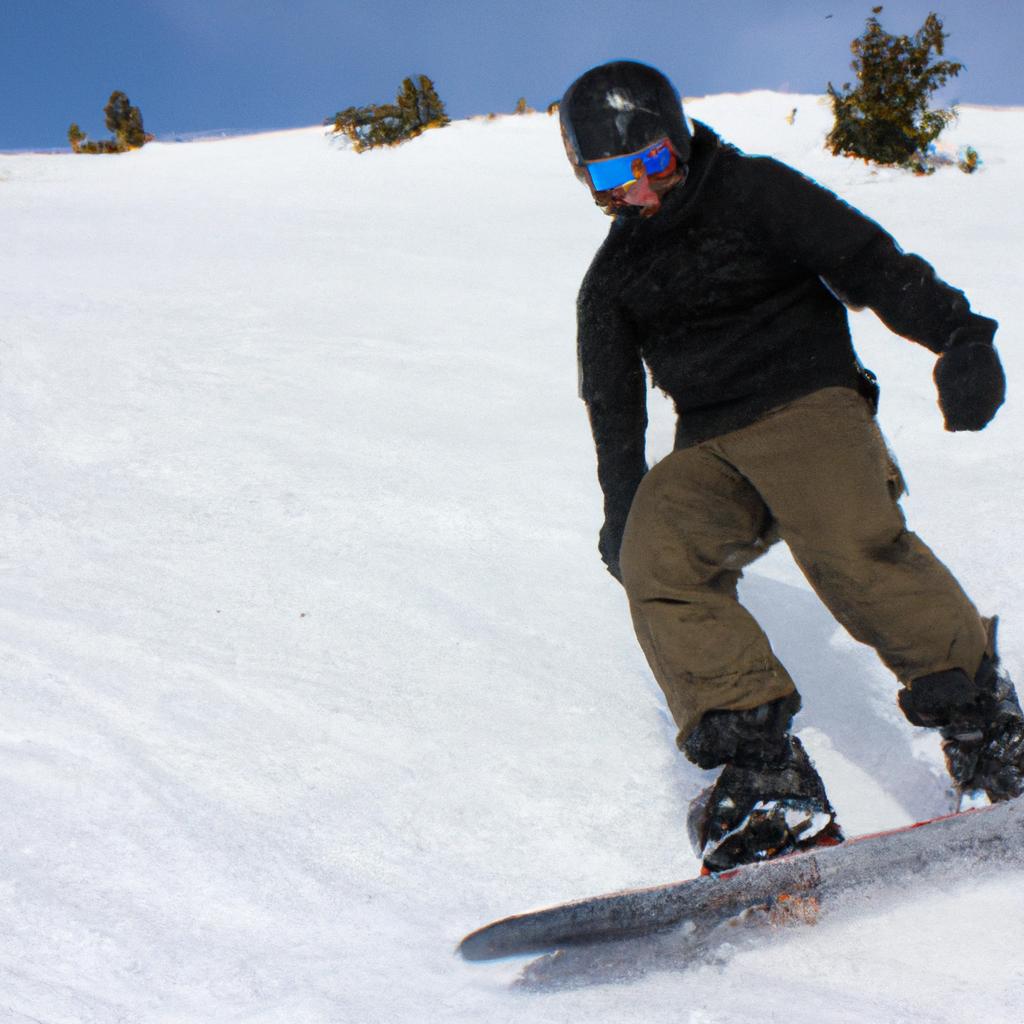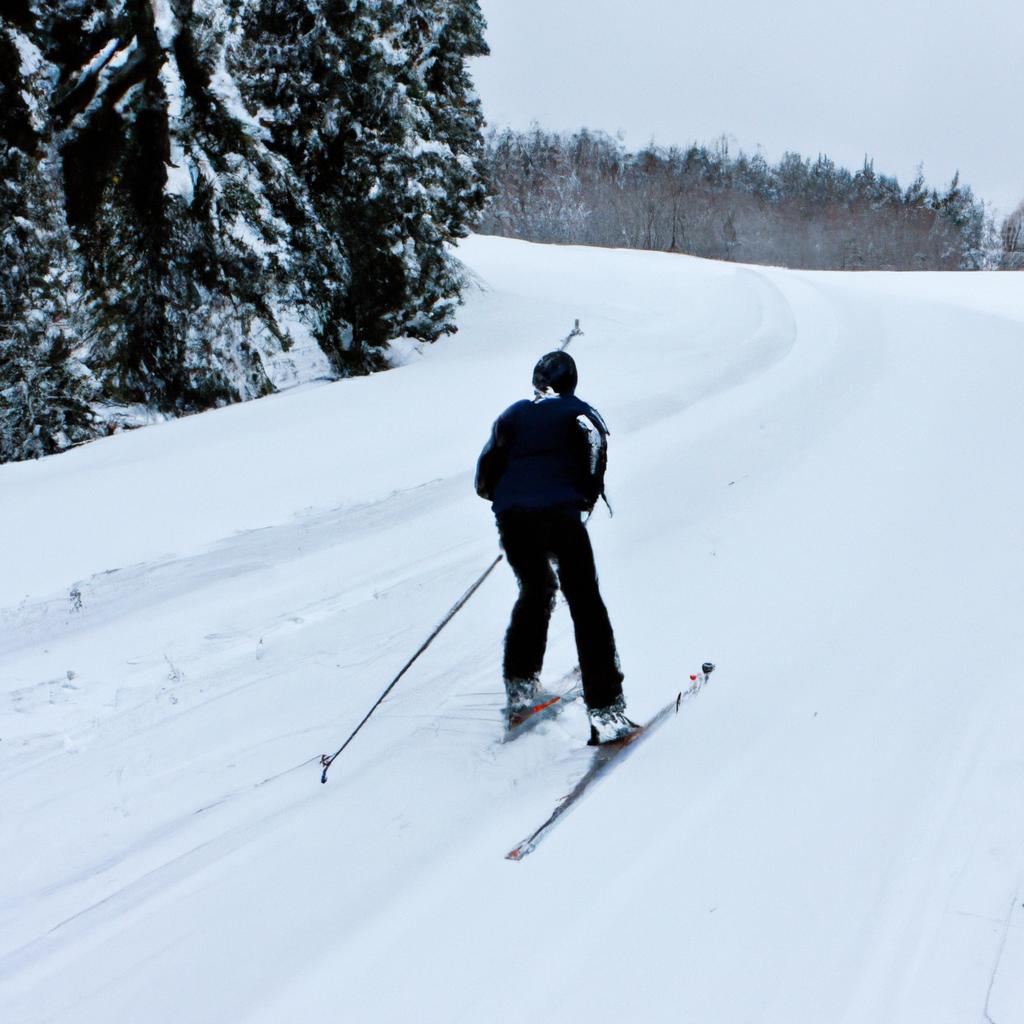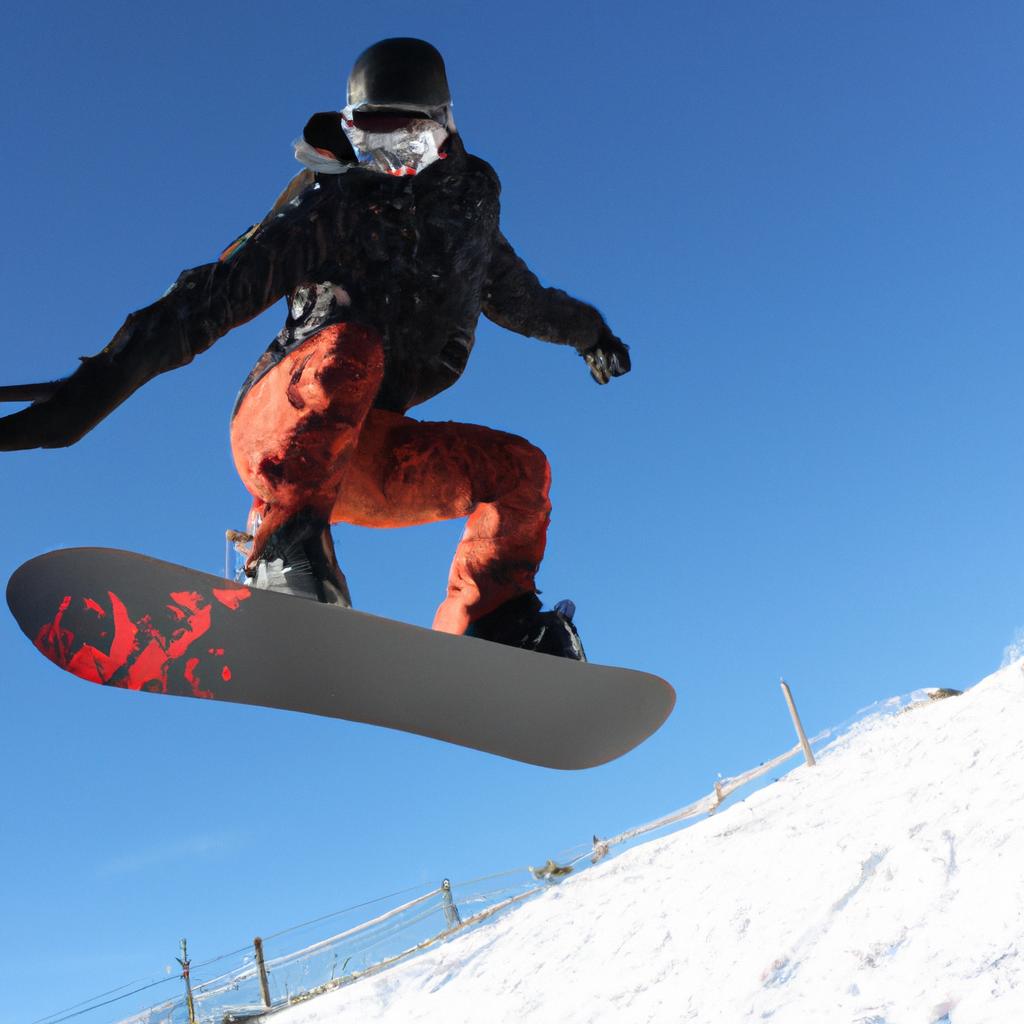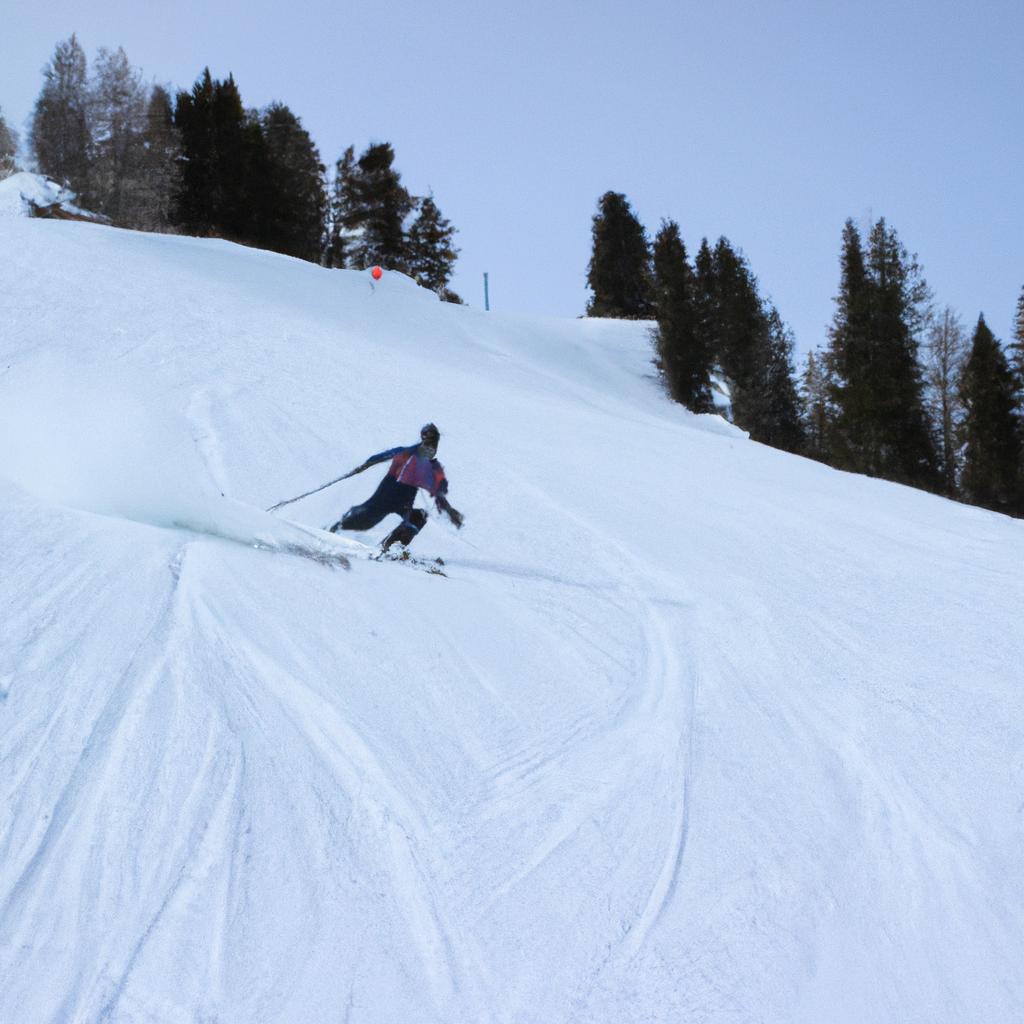Winter sports such as skiing and snowboarding offer exhilarating experiences for outdoor enthusiasts. However, they also come with inherent risks that require careful attention to safety precautions. This travel recreation guide aims to provide valuable insights on winter sports safety, specifically focusing on the popular activities of skiing and snowboarding.
Consider the case of Sarah, an avid skier who embarked on a weekend ski trip at a renowned mountain resort. Excitedly making her way down the slopes, she suddenly lost control and collided with another skier due to excessive speed. Although both parties escaped serious injury, this incident serves as a stark reminder of the importance of understanding and implementing proper safety measures in winter sports. With the number of participants engaging in skiing and snowboarding steadily increasing each year, it becomes imperative to equip individuals with essential knowledge regarding equipment usage, technique training, weather conditions assessment, and emergency preparedness. By addressing these key areas comprehensively, this guide seeks to promote safe participation in winter sports activities while maximizing enjoyment amidst snowy landscapes.
In order to ensure an informative yet engaging approach towards winter sports safety, this article will discuss various aspects related to skiing and snowboarding. It will delve into topics such as selecting appropriate gear based on skill level and terrain difficulty, utilizing correct techniques for utilizing correct techniques for turns, jumps, and stops, understanding the impact of weather conditions on snow quality and visibility, recognizing signs of avalanches and how to respond in such situations, and preparing for emergencies by carrying essential safety equipment and being familiar with resort policies.
When it comes to selecting appropriate gear for skiing or snowboarding, it is crucial to consider one’s skill level and the difficulty of the terrain. Beginners should opt for shorter skis or snowboards that are easier to maneuver, while more experienced individuals can choose longer ones for increased stability at higher speeds. It is also important to ensure that bindings are properly adjusted to prevent injuries caused by falls or excessive strain on joints.
Proper technique is key to maintaining control and avoiding accidents while skiing or snowboarding. For example, when making turns, it is essential to shift weight from one foot to another smoothly and maintain a balanced posture. This allows for better control over speed and direction. Similarly, learning how to execute proper jumps and landings can minimize the risk of injury. Techniques such as bending knees upon landing help absorb impact and reduce strain on the body.
Weather conditions play a significant role in winter sports safety. Snow quality varies depending on factors like temperature, humidity, and recent precipitation. Wet or icy snow can make it harder to maintain control while skiing or snowboarding. Additionally, reduced visibility due to fog or heavy snowfall can increase the risk of collisions with other participants or obstacles on the slopes. It is essential to check weather forecasts before heading out and adjust plans accordingly.
Avalanches pose a serious threat in mountainous regions where winter sports take place. Recognizing warning signs such as cracks in the snowpack, recent avalanche activity in the area, or changes in weather patterns is crucial. If caught in an avalanche, knowing how to react promptly can save lives. Carrying an avalanche transceiver (a device that emits signals) and practicing rescue techniques can greatly increase the chances of survival.
Lastly, being prepared for emergencies is vital. Carrying a backpack with essential safety equipment such as a first aid kit, a whistle for signaling help, and extra layers of clothing can be lifesaving in case of accidents or unexpected weather changes. It is also important to familiarize oneself with resort policies regarding emergency procedures and ski patrol contact information.
By considering these aspects of winter sports safety, individuals can enjoy skiing and snowboarding while minimizing the inherent risks. Remember, thorough preparation, proper technique, awareness of weather conditions, and emergency readiness are all key elements in ensuring a safe and enjoyable experience on the slopes. So gear up, stay informed, and have fun exploring the snowy wonders of winter sports!
Understanding the risks involved in winter sports
Understanding the Risks Involved in Winter Sports
Winter sports, such as skiing and snowboarding, are exhilarating activities that attract millions of enthusiasts each year. However, it is important to acknowledge the inherent risks associated with these sports to ensure a safe and enjoyable experience on the slopes.
To illustrate the potential dangers, let us consider an example: imagine a skilled skier who veers off course while tackling a challenging slope. Despite being experienced, they lose control and collide with a tree, resulting in serious injuries. This scenario highlights how even proficient individuals can be susceptible to accidents when engaging in winter sports.
It is crucial to recognize several key factors that contribute to risk during winter sports:
-
Environmental Conditions:
- Adverse weather conditions can decrease visibility and affect one’s ability to navigate safely.
- Treacherous terrain or hidden obstacles may increase the likelihood of falls or collisions.
-
Equipment Failure:
- Faulty equipment or improper maintenance can lead to unexpected malfunctions during high-speed descents.
-
Lack of Skill or Experience:
- Inadequate training and insufficient familiarity with proper techniques can amplify the chance of accidents occurring.
-
Human Error:
- Poor decision-making on the slopes, reckless behavior, or failure to adhere to safety guidelines can result in unfortunate incidents.
Awareness of these risks allows participants in winter sports to take precautionary measures for their own wellbeing. By understanding potential hazards, individuals can make informed choices regarding personal safety practices and appropriate gear selection.
In order to mitigate these risks effectively, it is essential for all skiers and snowboarders to equip themselves with suitable safety gear. The subsequent section will delve into this topic further by exploring essential equipment required for skiing and snowboarding adventures.
Remembering that prevention is key, ensuring one’s readiness through education about possible risks sets the foundation for an optimal winter sport experience. So now let us proceed towards examining vital safety gear for skiing and snowboarding.
Essential safety gear for skiing and snowboarding
Winter sports, such as skiing and snowboarding, offer exhilarating experiences for outdoor enthusiasts. However, it is important to understand the risks involved in these activities to ensure a safe and enjoyable experience. By being aware of potential hazards and taking necessary precautions, individuals can minimize the likelihood of accidents or injuries.
For instance, let’s consider a hypothetical scenario where an inexperienced skier fails to properly assess their ability level before attempting a challenging slope. This lack of self-awareness puts them at higher risk of losing control and potentially colliding with other skiers or objects on the slope. Additionally, poor weather conditions, such as low visibility due to heavy snowfall or fog, further increase the danger associated with winter sports.
To mitigate these risks effectively, there are several key factors that should be taken into consideration:
- Appropriate skill assessment: It is crucial for all participants to accurately evaluate their own abilities before engaging in any particular activity. Beginners should start with beginner-friendly slopes and gradually progress as they become more skilled.
- Equipment selection: Wearing proper safety gear significantly reduces the risk of injury while participating in winter sports. This includes helmets, goggles, gloves, and appropriate clothing designed for cold weather conditions.
- Familiarity with rules: Every ski resort has specific rules and guidelines that must be followed by all visitors. Understanding and adhering to these regulations not only ensures personal safety but also promotes a respectful environment for everyone on the slopes.
- Awareness of surroundings: Constant vigilance regarding one’s surroundings is essential during winter sports activities. Being mindful of other skiers’ movements, signposts indicating trail difficulties or closures, and potential obstacles can help prevent collisions or accidents.
These considerations form just a part of what individuals need to take into account when engaging in winter sports. To enhance safety further, it is important to explore additional measures such as regular exercise routines focused on strengthening relevant muscle groups used in skiing or snowboarding techniques.
By mastering these techniques, individuals can improve their control over their movements, reducing the likelihood of accidents or injuries while engaging in winter sports activities.
Proper techniques for skiing and snowboarding
Now that we have discussed the essential safety gear required for skiing and snowboarding, let us delve into the proper techniques necessary to enjoy these winter sports while minimizing risks. Understanding and practicing these techniques will enhance your experience on the slopes and contribute to a safer environment for all.
Paragraph 1:
Imagine this scenario: Sarah, an experienced skier, is preparing to tackle a challenging slope. As she begins her descent, she maintains a balanced stance with her weight evenly distributed between both feet. This fundamental technique ensures stability and control throughout each turn, reducing the likelihood of losing balance or encountering obstacles along the way. Additionally, Sarah adopts a forward-leaning position, allowing her to maintain better control over her speed and direction as she maneuvers down the mountain.
Paragraph 2:
To further enhance their skills on the slopes, skiers and snowboarders should practice effective turning techniques. By initiating turns through appropriate body movements rather than solely relying on equipment adjustments, individuals can improve their overall control and reduce accidents caused by sudden changes in trajectory. Furthermore, mastering carving techniques enables skiers to create beautiful arcs in the snow, providing them with greater stability during descents.
- Increased confidence
- Enhanced enjoyment
- Greater sense of accomplishment
- Improved overall performance
Paragraph 3:
In addition to proper stance and turning techniques, it is crucial for winter sports enthusiasts to familiarize themselves with etiquette guidelines on the slopes. Respectful behavior towards fellow skiers and snowboarders creates a harmonious environment where everyone can safely pursue their recreational activities. It includes following designated routes, avoiding abrupt stops at high traffic areas, yielding appropriately when merging onto trails or overtaking others, as well as refraining from reckless actions that may endanger oneself or others.
Table: Common Slope Etiquette Guidelines
| Guideline | Description |
|---|---|
| Yield to downhill skiers and snowboarders | Allow those below you on the slope the right of way |
| Stay visible when merging onto trails | Ensure visibility by looking uphill before entering a trail |
| Avoid stopping in narrow or blind spots | Prevent unexpected collisions by pausing in safe areas |
| Be mindful of speed | Adjust your pace according to your ability and terrain conditions |
Equipped with the essential safety gear and armed with proper techniques, we can now explore vital tips for staying safe on the slopes. By following these guidelines, you will be able to fully enjoy your skiing or snowboarding experience while minimizing potential risks.
Tips for staying safe on the slopes
Building a solid foundation of proper techniques is crucial when it comes to skiing and snowboarding. By mastering these skills, you will not only enhance your performance on the slopes but also reduce the risk of accidents and injuries. Now, let’s delve deeper into some key techniques that can help you navigate the snowy terrain with confidence.
Paragraph 1:
Consider this hypothetical scenario: You find yourself gliding effortlessly down a mountain slope, feeling the crisp winter air against your face as you carve through fresh powder. As exhilarating as it may be, skiing or snowboarding requires certain fundamental techniques to ensure control and balance throughout your descent. Here are some essential tips to keep in mind:
- Maintain a balanced stance by keeping your weight centered over the middle of your skis or snowboard.
- Bend your knees slightly and flex your ankles forward to absorb shocks and maintain stability.
- Use controlled turns to manage speed rather than relying solely on braking maneuvers.
- Practice good posture by keeping your upper body relaxed yet engaged, allowing for fluid movements.
Paragraph 2 (Bullet Point List):
Remember, safety should always be at the forefront of your mind when participating in winter sports activities. To further underscore its importance, here are four critical considerations:
- Wear appropriate protective gear such as helmets, goggles, wrist guards (for snowboarders), and knee pads.
- Stay well-hydrated throughout the day to prevent fatigue and dehydration-related issues.
- Warm up before hitting the slopes to prepare muscles for physical exertion and minimize injury risks.
- Familiarize yourself with trail maps and markers to avoid venturing off designated paths or closed areas.
| Skill Level | Recommended Equipment |
|---|---|
| Beginner | Skis or snowboard with soft flex, shorter length for better maneuverability. |
| Intermediate | Skis or snowboard with medium flex, moderate length to balance stability and agility. |
| Advanced | Skis or snowboard with stiff flex, longer length for increased speed and control. |
| Expert | Specialized skis or snowboards tailored to specific disciplines such as racing or freestyle. |
Transition into the subsequent section:
Understanding proper techniques is essential for enjoying winter sports safely, but it’s equally important to be aware of common injuries in these activities and how they can be prevented. Let’s explore this topic further in the next section.
Common injuries in winter sports and how to prevent them
Having discussed some essential tips for staying safe on the slopes, it is crucial to understand the common injuries that can occur while participating in winter sports. By recognizing these potential risks, individuals can take proactive measures to prevent such injuries from happening.
To illustrate the significance of injury prevention, consider a hypothetical scenario involving John, an avid snowboarder. During his last skiing trip, he experienced a severe knee injury after attempting a difficult jump without proper technique or protective gear. This incident highlights the importance of understanding common winter sport injuries and taking appropriate precautions.
Common Injuries:
-
Fractures:
- Often caused by falls or collisions.
- Mainly affect wrists, ankles, and collarbones.
- Symptoms include swelling, pain, and deformity.
- Prevention measures:
- Wear properly fitted protective gear like helmets and wrist guards.
- Practice good balance techniques and improve overall strength through regular exercise.
-
Sprains:
- Typically result from sudden twists or turns.
- Most commonly impact knees, elbows, and wrists.
- Signs include pain, swelling, limited range of motion.
- Prevention measures:
- Warm-up adequately before starting any physical activity.
- Strengthen muscles around joints through targeted exercises.
- Use braces or supports if necessary.
-
Head Injuries:
- Can occur due to falls or impacts with objects like trees or rocks.
- May lead to concussions or more severe traumatic brain injuries (TBI).
- Warning signs include dizziness, confusion, nausea/vomiting.
- Prevention measures:
- Always wear a certified helmet that fits properly.
- Follow trail rules and avoid risky behavior or excessive speed.
Table: Common Winter Sport Injuries
| Injury | Symptoms | Prevention Measures |
|---|---|---|
| Fractures | Swelling, pain, deformity | – Wear proper protective gear |
| – Practice good balance techniques | ||
| Sprains | Pain, swelling, limited motion | – Warm-up adequately |
| – Strengthen muscles around joints | ||
| Head Injuries | Dizziness, confusion, nausea/vomiting | – Always wear a certified helmet |
| – Follow trail rules and avoid risky behavior or excessive speed |
Understanding the common injuries associated with winter sports is crucial for individuals to protect themselves while enjoying these activities. By taking proactive measures such as wearing appropriate protective gear and practicing safe skiing or snowboarding techniques, enthusiasts can significantly reduce their risk of injury.
With knowledge about preventing common injuries in mind, it’s essential to also focus on safety measures to consider when planning a winter sports trip
Safety measures to consider when planning a winter sports trip
Common injuries in winter sports can be severe and have long-lasting effects on individuals. However, by following safety measures and taking precautions, many of these injuries can be prevented. Let’s explore some important safety measures to consider when planning a winter sports trip.
One example that highlights the importance of safety measures is the case of Sarah, an experienced snowboarder who failed to wear proper protective gear during her trip. While attempting a difficult trick, she lost control and collided with a tree, resulting in a serious head injury. This incident could have been avoided if Sarah had followed basic safety guidelines and worn a helmet.
To ensure your safety while enjoying winter sports, it is crucial to:
- Wear appropriate protective gear: Always wear helmets, goggles or sunglasses, wrist guards for snowboarding, knee pads for skiing, and layers of clothing suitable for cold weather conditions.
- Warm-up exercises: Engage in warm-up exercises before hitting the slopes to prevent muscle strains and tears.
- Know your limits: Be aware of your skill level and choose activities that match your abilities. Pushing yourself beyond what you are capable of increases the risk of accidents.
- Stay hydrated: It is important to drink plenty of water throughout the day to avoid dehydration caused by physical exertion and exposure to cold temperatures.
Furthermore, considering additional safety measures such as checking weather forecasts regularly before heading out, following marked trails or slopes designated for specific skill levels will further minimize risks associated with winter sports activities.
| Safety Measure | Importance |
|---|---|
| Wearing Protective Gear | High |
| Engaging in Warm-Up Exercises | Moderate |
| Knowing Your Limits | High |
| Staying Hydrated | Moderate |
In conclusion, prioritizing safety measures plays a vital role in preventing injuries during winter sports trips. By wearing appropriate protective gear like helmets and goggles, performing warm-up exercises beforehand, knowing our limitations, and staying hydrated, we can reduce the risk of accidents and ensure a safe and enjoyable winter sports experience. Remember, taking these precautions is essential for both beginners and experienced individuals alike. Stay safe on the slopes!




